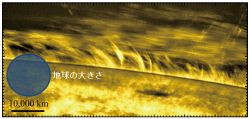Hinode Featured in Science
National Astronomical Observatory of Japan, National Institutes of Natural Sciences (NAOJ/NINS)
Institute of Space and Astronautical Science, Japan Aerospace Exploration Agency (ISAS/JAXA)
National Aeronautics and Space Administration (NASA)
Science and Technology Facilities Council (STFC)
European Space Agency (ESA)
Hinode (SOLAR-B) has brought us a new perspective of solar physics since its launch on September 22, 2006. Sience magazine, one of the leading journals of scientific research, features Hinode discoveries. An impressive picture obtained with Hinode appears in the front page of the journal. This press release highlights two of nine articles published in the special issue.
- Science Magazine Hinode Special Issue
http://www.sciencemag.org/content/vol318/issue5856/
- Continuous Plasma Outflows from the Edge of a Solar Active Region as a Possible Source of Solar Wind
T. Sakao1, R. Kano2, N. Narukage,1, J. Kotoku2, T. Bando2, E. E. DeLuca3 L. L. Lundquist3, S. Tsuneta2, L. K. Harra4, Y. Katsukawa2, M. Kubo5, H. Hara2, K. Matsuzaki1, M. Shimojo2, J. A. Bookbinder3 L. Golub3, K. E. Korreck3, Y. Su3, K. Shibasaki2, T. Shimizu1, and I. Nakatani1
1Institute of Space and Astronautical Science, Japan Aerospace Exploration Agency (ISAS/JAXA)
2National Astronomical Observatory of Japan, National Institutes of Natural Sciences (NAOJ/NINS)
3Harvard-Smithsonian Center for Astrophysics
4Mullard Space Science Laboratory (MSSL)
5High Altitude Observatory, The National Center for Atmospheric Research (HAO/NCAR)
Figure 1 presents an active region corona adjacent to an equatorial coronal hole observed with XRT/Hinode. The sequence of images display continuous plasma outflow from the edge of the active region (white curcle in Fig. 1). Apparent velocity of the outflow is 140 km/s. Magnetic field extrapolartion from full disk magnetogram suggests that roots of the open magnetic field are co- spatial with the plasma outflow region. Hinode allowed us to identify the source region of the low speed solar wind for the first time. This discovery will contribute to the study of solar wind which affects terrestrial environment.
- Movie [Pseudo-color] (JAXA/NAOJ)
- Close-up Movie [Pseudo-color] (JAXA/NAOJ)

© JAXA/NAOJ
Figure 1. The corona of active region adjacent to a coronal hole, seen by XRT/Hinode. A circle in the bottom indicates the size of the Earth.
2.Coronal Transverse Magnetohydrodynamic Waves in a Solar Prominence
T. Okamoto1, S. Tsuneta1, T. E. Berger2, K. Ichimoto1, Y. Katsukawa1,B. W. Lites3, S. Nagata4, K. Shibata4, T. Shimizu5, R. A. Shine2, Y. Suematsu1, T. D. Tarbell2, and A. M. Title2
1National Astronomical Observatory of Japan, National Institutes of Natural Sciences (NAOJ/NINS)
2Lockheed Martin Solar and Astrophysics Laboratory (LMSAL)
3High Altitude Observatory, The National Center for Atmospheric Research (HAO/NCAR)
4Kwasan and Hida Observatories, Kyoto University
5Institute of Space and Astronautical Science, Japan Aerospace Exploration Agency (ISAS/JAXA)
Figure 2 displays a limb prominence above an active region observed with SOT/Hinode. Prominences are floating cool plasma in the hot corona. High resolution images in Ca II H spectral line revealed waving motion of the prominence. Detailed analysis proved that the motion is attributed to Alfvén wave in the corona. This observational result holds vital clues for understanding the coronal heating.
- Movie [Pseudo-color] (JAXA/NAOJ)

© JAXA/NAOJ
Figure 2. Alfvén wave in the active region prominence observed by SOT/Hinode. A circle in the left indicates the size of the Earth.
Regarding the use of images and movies on the page concerned, please visit the page here. The credits of images and movies on this page are “NAOJ/JAXA” unless explicitly stated to the contrary. Regarding images and movies on this page the credits of which are “NAOJ/JAXA”, "NAOJ/JAXA/MSU", or “NAOJ, JAXA, NASA/MSFC”, terms of use for Copyrighted Works owned by NAOJ can be applied. In using the images and movies, the credits should be given.
